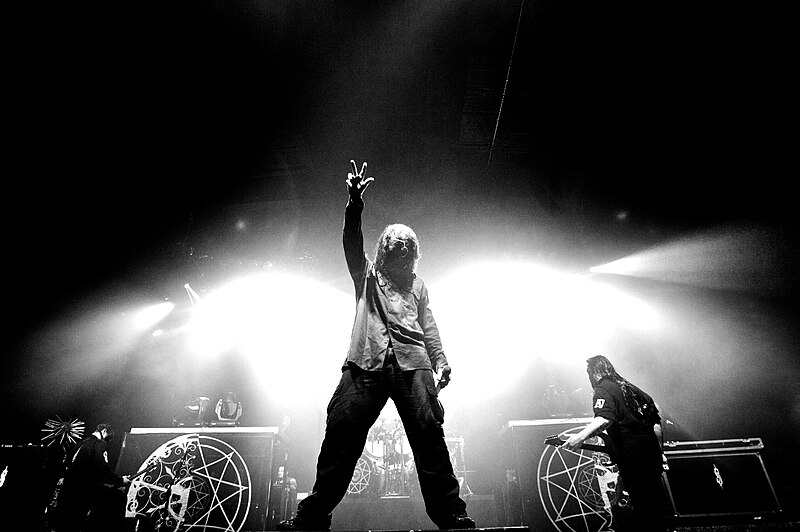 Slipknot is an American heavy metal band from Des Moines, Iowa. Formed in 1995, the group was founded by percussionist Shawn Crahan and bassist Paul Gray, after several lineup changes in their early days the band consisted of nine members for the greater part of their tenure—Sid Wilson, Paul Gray, Joey Jordison, Chris Fehn, Jim Root, Craig Jones, Shawn Crahan, Mick Thomson, and Corey Taylor. However, the death of Paul Gray on May 24, 2010 left the band with only eight remaining members. The future of Slipknot is currently unclear due to their current hiatus and reluctance to comment on the situation.
Slipknot is an American heavy metal band from Des Moines, Iowa. Formed in 1995, the group was founded by percussionist Shawn Crahan and bassist Paul Gray, after several lineup changes in their early days the band consisted of nine members for the greater part of their tenure—Sid Wilson, Paul Gray, Joey Jordison, Chris Fehn, Jim Root, Craig Jones, Shawn Crahan, Mick Thomson, and Corey Taylor. However, the death of Paul Gray on May 24, 2010 left the band with only eight remaining members. The future of Slipknot is currently unclear due to their current hiatus and reluctance to comment on the situation.Slipknot are known largely by their attention-grabbing image, aggressive music style and their energetic and chaotic live shows. The band had somewhat of a meteoric rise to success following the release of their self-titled debut album in 1999. The 2001 follow-up album Iowa further increased the band's popularity. After breaking for their first hiatus, Slipknot returned in 2004 with Vol. 3: (The Subliminal Verses) and once again in 2008 with their fourth album All Hope Is Gone, which debuted at the top spot on the Billboard 200 charts. The band has also released one live album and four DVDs. As of May 2010, Slipknot has sold over 14 million records worldwide.
History
Early days (1995–1998)
Slipknot was formed in Des Moines, Iowa, in September 1995 when drummer Shawn Crahan and bassist Paul Gray started a band named The Pale Ones.[2] The lineup was made up of friends who met through the local music scene, including vocalist Anders Colsefni and guitarist Donnie Steele.[2] Not long after their inception, Gray invited Joey Jordison to a rehearsal because the band were interested in experimenting with additional drum elements. Jordison subsequently joined the band as their main drummer, moving Crahan to custom percussion.[2] Furthermore, Colsefni also took up custom percussion while remaining the band's vocalist. The band then decided to invite Donnie Steele as their second guitarist, bringing their lineup to six members.[3] On December 4, the band made their live debut; playing a benefit show using the name Meld.[4]A lot of the band's early development was retrospectively attributed to late-night planning sessions between Gray, Crahan and Jordison at a Sinclair gas station where Jordison worked nights. It was there, in late 1995, that Jordison suggested changing the band name to Slipknot after their song of the same name.[3] In December, Slipknot began recording material at SR Audio, a studio in the band's hometown.[5] Without a recording budget, the band were forced to self-finance the project, the costs of which came to an estimated $40,000.[6] In February 1996, guitarist Donnie Steele decided to leave Slipknot due to his Christian beliefs. When questioned in 1999 about Steele's departure, Jordison explained: "we were prepared to keep him on, but he didn't want to stay." During the mixing stages of their project at SR Audio, Craig Jones was recruited as Steele's replacement on guitar.[7] However, throughout their time in the studio, the band were adding samples to their recordings but could not produce these sounds live. Subsequently, Jones became the band's sampler and Mick Thomson was brought in as the replacement guitarist.[8] After a complicated time with mixing and mastering, the band self-released the demo album Mate. Feed. Kill. Repeat. on Halloween, October 31, 1996.[9]
 | 29 second sample from the song "Slipknot" which the band was eventually named after. Slipknot's earlier music was slower than their later material and vocalist Colsefni had a much deeper vocal style than that of Taylor.[10] |
| Problems listening to this file? See media help. | |
Chris Fehn was brought in to replace Welts on percussion before Slipknot traveled to Malibu, California to work on their debut album in September 1998.[20] Partway through the recording process of the album, Slipknot returned to Des Moines, Iowa for the Christmas period, during which guitarist Brainard decided to leave the band.[21] Speaking about his decision, Brainard explained: "some decisions were made that I wasn't particularly happy with."[22] Slipknot recruited Jim Root to complete their lineup and returned to Malibu to continue work on their debut album.[22] Work on the album concluded in early 1999, allowing the band to go on their first tour as part of the Ozzfest in 1999.[9] The tour proved to expand their audience greatly and their debut album Slipknot was released on June 29, 1999.[23] Slipknot went on to release their first home video Welcome to Our Neighborhood and the two singles; "Wait and Bleed" and "Spit It Out".[9] The singles received some airplay, but Slipknot developed a large following very quickly mainly from touring and word of mouth.[9] The band toured several countries throughout 1999 and 2000 in support of the album. In early 2000, Slipknot was certified platinum, a first for an album released by Roadrunner Records.
http://en.wikipedia.org
